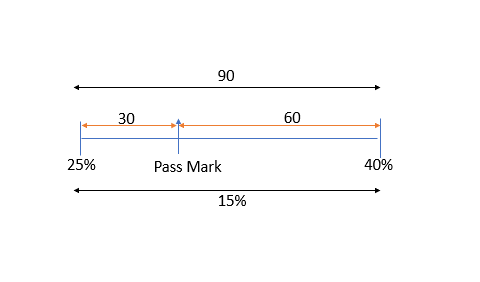In addition to covering foundational mathematical tricks, this guide aims to introduce some of the most critical techniques for excelling in competitive exams. It is essential to focus on understanding the underlying concepts rather than solely relying on the terminology. However, memorizing both the names and applications of these methods can be beneficial for you and even for teaching others effectively.
We will strive to explain these concepts clearly, and we encourage you to approach the material with patience and persistence as you progress.
Try solving this:
In an exam one student get 25% marks and fails by 30 marks. Another student get 40% which is 60 more than the passing mark. Find full marks in the exam?
Generally we would solve like this.
Let total marks = x
So, pass marks = \displaystyle {\frac{25}{100}x+30} = \displaystyle \frac{40}{100}x-60
On solving, x = 600
Hence full marks = 600.
But this can be solved in more time efficient way. See below….
15% = 90
⇒ 100% = 600
Hence full marks = 600.
Wonder how this work! Keep going.
How to use Total = 100% ?
- Read the question and find out what % equals to what actual number that can be interpreted from the question
- Find the required% using unitary method with the help of interpreted value.
Question: In an exam one student get 25% marks and fails by 30 marks. Another student get 40% which is 60 more than the passing mark. Find full marks in the exam?
(a) 150
(b) 180
(c) 600
(d) None of these
Ans: (c) 600
Explanation:

Percentage marks difference = 40% – 25% = 15%
Marks difference = 60 + 30 = 90 (Since one’s marks less than passing marks and another’s is more than passing marks)
∴ 15% = 90
⇒ 100% = 600
Hence full marks = 600.
Where to use Total = 100% ?
This method can be applicable to
- Percentage Problems
- Profit and Loss Problems
- Simple Interest Problems
Application on Percentage
Here, base of calculation = 100%
Question: In a class 70% students are present and 90 students are absent. Find total number of students?
Ans: 300
Explanation:
30% students are absent
∴ 30% = 90
⇒ 100% = 300
Question: In an election contest between 2 candidates one get 60% vote and wins by a majority of 400 votes. Find the total number of votes?
Ans: 2000
Explanation:
Votes by winner = 60%
and votes by loser = 40%
Difference = 60% – 40% = 20%
∴ 20% = 400
⇒ 100% = 2000
Question: In an exam one student get 25% marks and fails by 30 marks. Another student get 40% which is 60 more than the passing mark. Find the passing percentage?
Ans: 30%
Explanation:
Passing marks = (25% + 30) OR (40% – 60)
15% = 90
⇒ 25% = 150
⇒ 100% = 600
Hence passing marks = 150 + 30 = 180
Pass percentage = \displaystyle \frac{180}{600}\times 100 = 30\%
Application on Profit and Loss
Here base of calculation, CP = 100%
Question: A man sales an article at a loss of 10%, if he had sold the article at ₹30 more, he could have got a profit 5%. find his cost price?
Ans: 200
Explanation:
15% = 30
⇒ 100% = 200
Question: A man sells an article at ₹230 and gains 15%. Find the cost price of the article?
Ans: ₹200
Explanation:
Selling price is 115% of CP since profit is 15%
∴ 115% = 230
⇒ 100% = 200
Question: By selling an article at ₹270 a man losses 10%. At what price should he sell it so as to get 20%?
Ans: ₹360
Explanation:
∴ 90% = 270
⇒ 120% = 360
Application on Simple Interest
Here base of calculation, Principal = 100%
Question: A sum of money deposit in a bank for a period of 4 year at 8.5% p.a simple interest earns an interest of Rs 850. Find the sum.
We know, simple interest is equal for every year.
Rate = 4 × 8.5% = 34%
∴ 34% = 850
⇒ 100% = \displaystyle\frac{850\times 100}{34} = 2500
Question: A man deposits a certain amount in a bank at 7% per annum simple interest. If he had deposited the same money in a post office, he could get 8.5% per annum and in that case he would have received ₹300 more. How much money had he deposited in the bank?
Ans: ₹20000
Explanation:
∴ 1.5% = 300
⇒ 100% = 20000
Question: Susmita lent some money to Mohit at 5% per annum simple interest. Mohit lent the entire amount to Birju on the same day at 8 \displaystyle\frac{1}{2}\% per annum. In this transaction after a year Mohit earned a profit of Rs. 350. Find the sum of money lent by Susmita to Mohit.
Ans: Rs. 10000
Explanation:
Mohit earned a profit of (8.5 – 5 )% = 3.5%
∴ 3.5% = 350
⇒ 100% = 10000
Question: Two equal sums of money were invested, one at 4% and other at 4 \displaystyle\frac{1}{2}\%. At the end of 7 years, the simple interest received from the later exceeded that received from the former by Rs. 31.50. Each sum was
Ans: Rs. 900
Explanation:
For simple interest interest rate is same for every year. Here we have to find difference for 7 years.
Interest difference = (4.5 -4)% × 7 = 3.5%
∴ 3.5% = 31.50
⇒ 100% = \displaystyle\frac{315}{35}\times 100 = 900
You may check out our simple interest problems post also.
Other Post You may like:
*Most important maths tricks for any exam – AB Method
**Most important maths tricks for any exam – Line Method

Pingback: Percentage Problems for Competitive Exams
Pingback: Profit and Loss - Concepts and Solved Examples
Pingback: Simple Interest - logical approach for quick solving
This is very helpful content. I like it. Continue…
Thanks 👍